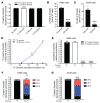Creatine riboside is a cancer cell-derived metabolite associated with arginine auxotrophy
- PMID: 35838048
- PMCID: PMC9282934
- DOI: 10.1172/JCI157410
Creatine riboside is a cancer cell-derived metabolite associated with arginine auxotrophy
Abstract
The metabolic dependencies of cancer cells have substantial potential to be exploited to improve the diagnosis and treatment of cancer. Creatine riboside (CR) is identified as a urinary metabolite associated with risk and prognosis in lung and liver cancer. However, the source of high CR levels in patients with cancer as well as their implications for the treatment of these aggressive cancers remain unclear. By integrating multiomics data on lung and liver cancer, we have shown that CR is a cancer cell-derived metabolite. Global metabolomics and gene expression analysis of human tumors and matched liquid biopsies, together with functional studies, revealed that dysregulation of the mitochondrial urea cycle and a nucleotide imbalance were associated with high CR levels and indicators of a poor prognosis. This metabolic phenotype was associated with reduced immune infiltration and supported rapid cancer cell proliferation that drove aggressive tumor growth. CRhi cancer cells were auxotrophic for arginine, revealing a metabolic vulnerability that may be exploited therapeutically. This highlights the potential of CR not only as a poor-prognosis biomarker but also as a companion biomarker to inform the administration of arginine-targeted therapies in precision medicine strategies to improve survival for patients with cancer.
Keywords: Cancer; Lung cancer; Oncology.
Conflict of interest statement
Figures










Similar articles
-
Improved detection and precise relative quantification of the urinary cancer metabolite biomarkers - Creatine riboside, creatinine riboside, creatine and creatinine by UPLC-ESI-MS/MS: Application to the NCI-Maryland cohort population controls and lung cancer cases.J Pharm Biomed Anal. 2020 Nov 30;191:113596. doi: 10.1016/j.jpba.2020.113596. Epub 2020 Sep 1. J Pharm Biomed Anal. 2020. PMID: 32937240 Free PMC article.
-
Noninvasive urinary metabolomic profiling identifies diagnostic and prognostic markers in lung cancer.Cancer Res. 2014 Jun 15;74(12):3259-70. doi: 10.1158/0008-5472.CAN-14-0109. Epub 2014 Apr 15. Cancer Res. 2014. PMID: 24736543 Free PMC article.
-
Unique and Novel Urinary Metabolomic Features in Malignant versus Benign Adrenal Neoplasms.Clin Cancer Res. 2017 Sep 1;23(17):5302-5310. doi: 10.1158/1078-0432.CCR-16-3156. Epub 2017 Apr 27. Clin Cancer Res. 2017. PMID: 28450405 Free PMC article.
-
Metabolic pathways of L-arginine and therapeutic consequences in tumors.Adv Med Sci. 2019 Mar;64(1):104-110. doi: 10.1016/j.advms.2018.08.018. Epub 2018 Dec 31. Adv Med Sci. 2019. PMID: 30605863 Review.
-
Targeting arginine metabolism pathway to treat arginine-dependent cancers.Cancer Lett. 2015 Aug 1;364(1):1-7. doi: 10.1016/j.canlet.2015.04.020. Epub 2015 Apr 23. Cancer Lett. 2015. PMID: 25917076 Review.
Cited by
-
Urinary Metabolite Diagnostic and Prognostic Liquid Biopsy Biomarkers of Lung Cancer in Nonsmokers and Tobacco Smokers.Clin Cancer Res. 2024 Aug 15;30(16):3592-3602. doi: 10.1158/1078-0432.CCR-24-0637. Clin Cancer Res. 2024. PMID: 38837903 Free PMC article.
-
Gastric Cancer and Intestinal Metaplasia: Differential Metabolic Landscapes and New Pathways to Diagnosis.Int J Mol Sci. 2024 Sep 1;25(17):9509. doi: 10.3390/ijms25179509. Int J Mol Sci. 2024. PMID: 39273456 Free PMC article.
-
Extracellular matrix profiles determine risk and prognosis of the squamous cell carcinoma subtype of non-small cell lung carcinoma.Genome Med. 2022 Nov 21;14(1):126. doi: 10.1186/s13073-022-01127-6. Genome Med. 2022. PMID: 36404344 Free PMC article.
-
Development and investigation of metabolism-associated risk assessment models for patients with viral hepatitis.Front Cell Infect Microbiol. 2023 Mar 29;13:1165647. doi: 10.3389/fcimb.2023.1165647. eCollection 2023. Front Cell Infect Microbiol. 2023. PMID: 37065201 Free PMC article.
-
Making liver cancer cells go ARGh!EMBO J. 2022 Nov 2;41(21):e112415. doi: 10.15252/embj.2022112415. Epub 2022 Oct 12. EMBO J. 2022. PMID: 36222348 Free PMC article.
References
-
- Fendt SM, et al. Targeting metabolic plasticity and flexibility dynamics for cancer therapy. Cancer Discov. 2020;10(12):1797–1807. doi: 10.1158/2159-8290.CD-20-0844. - DOI - PMC - PubMed

